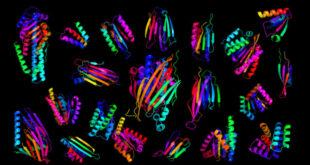Hyperbaric oxygen treatments may induce significant senolytic effects in healthy aging adults, according to new research from Tel Aviv University and the Shamir Medical Center.
Hachmo et al. prove that the aging process can be reversed at the basic cellular-molecular level.
Aging can be characterized by the progressive loss of physiological integrity, resulting in impaired functions and susceptibility for diseases and death. This biological deterioration is considered a major risk factor for cancer, cardiovascular diseases, diabetes and Alzheimer’s disease among others.
At the cellular level, there are two key hallmarks of the aging process: shortening of telomere length and cellular senescence.
Telomeres are tandem nucleotide repeats located at the end of the chromosomes which maintain genomic stability. They shorten during replication due to the inherent inability to fully replicate the end part of the lagging DNA strand.
Telomere length, measuring between 4 to 15 kilobases, gradually shorten by 20-40 bases per year and is associated with different diseases, low physical performance and cortical thinning of the brain.
When telomere length reaches a critical length, cells cannot replicate and progress to senescence or programmed cell death.
Cellular senescence is an arrest of the cell cycle which can be caused by telomere shortening, as well as other aging associated stimuli independent of telomere length such as non-telomeric DNA damage.
The primary purpose of senescence is to prevent propagation of damaged cells by triggering their elimination via the immune system.
The accumulation of senescent cells with aging reflects either an increase in the generation of these cells and/or a decrease in their clearance, which in turn aggravates the damage and contributes to aging.
“Today telomere shortening is considered the ‘Holy Grail’ of the biology of aging,” said Professor Shai Efrati, a researcher in the Sackler School of Medicine and the Sagol School of Neuroscience at Tel Aviv University and founder and director of the Sagol Center of Hyperbaric Medicine at the Shamir Medical Center.
“Researchers around the world are trying to develop pharmacological and environmental interventions that enable telomere elongation.”
Professor Efrati and colleagues found that a unique protocol of treatments with high-pressure oxygen in a pressure chamber can reverse the two major aging processes.
“For many years our team has been engaged in hyperbaric research and therapy — treatments based on protocols of exposure to high-pressure oxygen at various concentrations inside a pressure chamber,” Professor Efrati said.
“Our achievements over the years included the improvement of brain functions damaged by age, stroke or brain injury.”
“In the current study, we wished to examine the impact of hyperbaric oxygen treatments (HBOTs) on healthy and independent aging adults, and to discover whether such treatments can slow down, stop or even reverse the normal aging process at the cellular level.”
In the study, the scientists exposed 35 healthy individuals aged 64 or over to a series of 60 hyperbaric sessions over a period of 90 days.
Each participant provided blood samples before, during and at the end of the treatments as well as some time after the series of treatments concluded.
The autrhors then analyzed various immune cells in the blood and compared the results.
Their findings indicated that the treatments actually reversed the aging process in two of its major aspects.
The telomeres at the ends of the chromosomes grew longer instead of shorter, at a rate of 20%-38% for the different cell types.
The percentage of senescent cells in the overall cell population was reduced significantly – by 11%-37% depending on cell type.
“Our HBOT protocol was able to achieve this, proving that the aging process can in fact be reversed at the basic cellular-molecular level,” Professor Efrati said.
“Until now, interventions such as lifestyle modifications and intense exercise were shown to have some inhibiting effect on telomere shortening,” said Dr. Amir Hadanny, chief medical research officer of the Sagol Center for Hyperbaric Medicine and Research at the Shamir Medical Center.
“But in our study, only three months of HBOT were able to elongate telomeres at rates far beyond any currently available interventions or lifestyle modifications.”
“With this pioneering study, we have opened a door for further research on the cellular impact of HBOT and its potential for reversing the aging process.”
The study was published in the journal Aging.
_____
Y. Hachmo et al. Hyperbaric oxygen therapy increases telomere length and decreases immunosenescence in isolated blood cells: a prospective trial. Aging, published online November 18, 2020; doi: 10.18632/aging.202188
 #Bizwhiznetwork.com Innovation ΛI |Technology News
#Bizwhiznetwork.com Innovation ΛI |Technology News




